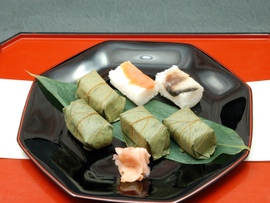
Kakinoha zushi

NaraKakinoha zushi
Classification (Large)
Seafood products
Classification (Small)
Other seafood products
Main ingredients used
Mackerel, persimmon leaves, vinegared rice
When using downloaded images, please read the "Terms of Use" and clearly state that the source of the image is "Traditional Foods in Japan" by the Ministry of Agriculture, Forestry and Fisheries.
If the photo credits is stated, please include it as well.
Example of description
of the photo credits
Example of description when the photo credits is not stated
Source: "Traditional Foods in Japan" Ministry of Agriculture, Forestry and Fisheries
Example of description when the photo credits is stated
Source: "Traditional Foods in Japan" Ministry of Agriculture, Forestry and Fisheries
Photo credits:xxx

Photo credits:Nara Prefecture
This image isunavailable.

Photo credits:Nara Prefecture
This image isunavailable.
Region of inheritance
Gojo City, Yoshino Town
Product overview (special characteristics and types)
Kakinoha zushi is sushi that is made by first placing slices of mackerel or salmon onto vinegared rice, then wrapping it in a persimmon leaf before pressing down on it. It is a food that makes clever use of the antioxidant and sterilization properties of persimmon leaves.
Kakinoha zushi has been passed down as a local food of Gojo City and Yoshino Town but it is now known throughout Japan as a specialty of Nara Prefecture. Due to it not requiring chopsticks for eating, it has become a popular eki-ben, a packed meal that is usually eaten on trains.
History and culture
The Kumano Highway that connected the eastern regions of Kumano-Shingu and the western regions of Yoshino-Gojo was also known as Yamato’s “Mackerel Highway.” The mackerel that was caught in the Kumano Sea, after being cured, would be delivered to Yamato (present-day Nara Prefecture) via the Mackerel Highway.
The Gojo and Yoshino regions where persimmons are grown, the mackerel would be thinly sliced and placed upon balls of rice. These balls of rice were then wrapped up individually in persimmon leaves before they were packed tightly into a wooden container called an oke, after which a heavy stone would be set on them to compress them as they aged, forming the beginnings of the food we now know as Kakinoha zushi. During those times, vinegar wasn’t used. Instead, the rice and fish were allowed to ferment, producing narezushi, a dish that brought something different to the table every day through its evolving tastes.
There are several estimates as to when exactly Kakinoha zushi was created. Some say it was during the Northern and Southern Courts Period, while others say it was created in the 1800s.
The mackerel, salt, and rice that was brought from afar in those days were seen as valuable commodities and were therefore served mainly at sacred rites or celebrations. Families that lived in mountain villages would prepare Kakinoha zushi for special occasions, leading to the dish being passed on from generation to generation within the local food culture.
The oblong shape of Kakinoha zushi that is familiar in present-day comes from when railway stations started selling it as an eki-ben, a packed meal. Kakinoha zushi became famous as an eki-ben, gaining popularity at eki-ben competitions and promotional events at department stores, leading to a rise in production. This was how the rest of Japan came to know Kakinoha zushi as a specialty product of Nara Prefecture.
There are now scores of specialty stores selling Kakinoha zushi. The ingredients are not limited to salt-cured mackerel, with seasonal fish like salmon, grilled mackerel and grilled conger eel also used.
Production method
The modern-day production method is as follows: Strip off the skin of the cured mackerel. Gut, clean, and slice thinly. Combine vinegar that has been seasoned with dashi or other condiments with the rice and spread the mixture evenly on the bottom of the mold, pressing down lightly. Separate a bite-sized amount of rice from the mixture, place a slice of mackerel on it and wrap it in a persimmon leaf. Arrange the pieces on the base of a wooden barrel, leaving no gaps, and cover before placing a heavy stone on top. Leave overnight.
Other than mackerel, fish such as salmon, sea bream, and grilled conger eel are also used in the production of Kakinoha zushi.
Conservation and succession efforts
Thanks to its shelf life and how easy it is to eat Kakinoha zushi without utensils, specialty stores have been opening up in succession. The stores compete to offer the best taste, developing the dish so that it now employs a host of different toppings apart from mackerel.
In specialty stores located in Nara Prefecture, hands-on Kakinoha zushi workshops are held to have people experience how to make the dish, promoting the passing down and preservation of this local food culture.
Main consumption method
The rich flavors of Kakinoha zushi are balanced by leaving the fish and vinegared rice overnight in aromatic persimmon leaves. Due to the antibacterial properties of the leaves, Kakinoha zushi also enjoys a longer shelf life than regular sushi, and is thus also suitable for gift-giving.
Some enjoy their Kakinoha zushi by grilling or broiling the sushi while it is still wrapped in its leaf in an oven toaster, allowing them to savor the fragrances of both the mackerel and the persimmon leaves.


